American film actress Jane Russell (1921-2011) was one of Hollywood's leading sex symbols in the 1940s and 1950s. She became an icon with her first film role in Howard Hughes' The Outlaw (1943). Her biggest hit was the musical Gentlemen Prefer Blondes (1953) in which she played Dorothy Shaw opposite Marilyn Monroe's Lorelei Lee.

Vintage postcard. Photo: George Hurrell. Publicity still for The Outlaw (Howard Hughes, 1943).

Belgian collectors Card, no. A 50. Photo: Paramount. Jane Russell in The Paleface (Norman Z. McLeod, 1948).
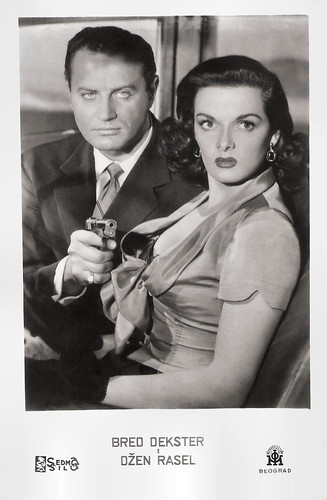
Yugoslavian postcard by Sedmo Silo / IOM, Beograd. Photo: Jane Russell and Brad Dexter in The Las Vegas Story (Robert Stevenson, 1952).

Italian postcard by Bromofoto, Milano, no. 378. Photo: Paramount Films. Jane Russell in Son of Paleface (Frank Tashlin, 1952).
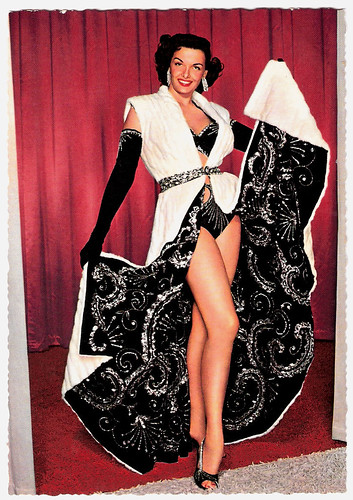
German postcard by Krüger, no. 902/16.
Ernestine Jane Geraldine Russell was born in 1921, in Bemidji, Minnesota. She was the only daughter of the five children of Geraldine (née Jacobi) and Roy William Russell. She had four younger brothers: Tom Russell, Kenny Russell, James H. Russell and Wally Russell. Her father had been a first lieutenant in the U.S. Army, and her mother an actress with a road troupe. When Jane was two, her family moved to Southern California where her father worked as an office manager.
Russell's mother arranged for her to take piano lessons. In addition to music, she was interested in drama and participated in stage productions at Van Nuys High School. Her early ambition was to be a designer of some kind, until the death of her father in his mid-40s, when she decided to work as a receptionist after graduation. She also modeled for photographers, and, at the urging of her mother, studied drama and acting with Max Reinhardt's Theatrical Workshop and with acting coach Maria Ouspenskaya.
In 1940, Jane Russell was signed to a seven-year contract by film mogul, Howard Hughes. She made her film debut in the Western The Outlaw (Howard Hughes, 1943), a story about Billy the Kid (Jack Buetel) that went to great lengths to showcase Russell's voluptuous figure. The film was completed in 1941, but it was not released until 1943 in a limited release. Hughes' battles with the censors resulted in the film spending three years on the shelf before finally gaining wide release in a cut version in 1946.
During that time, Russell was kept busy doing publicity and she became known nationally. The film and the controversy turned her into an icon. She was a popular pin-up photo with servicemen during World War II. Wikipedia cites Russell: "Sex appeal is good - but not in bad taste. Then it's ugly. I don't think a star has any business posing in a vulgar way. I've seen plenty of pin-up pictures that have sex appeal, interest, and allure, but they're not vulgar. They have a little art to them. Marilyn's calendar was artistic."
Russell did not appear in another film until 1946, when she played Joan Kenwood in Young Widow (Edwin L. Marin, 1946) opposite Louis Hayward, released through United Artists. The film went over budget by $600,000 and was a box office failure. In 1947 Russell delved into music before returning to films. She sang with the Kay Kyser Orchestra on radio, and recorded two singles with his band. Then, she played Calamity Jane opposite Bob Hope in The Paleface (Norman Z. McLeod, 1948). The film was a sizeable box office hit, earning $4 million. She later also played Mike 'the Torch' Delroy opposite Hope in another Western comedy, Son of Paleface (Frank Tashlin, 1952). It was also a hit.
In between, Howard Hughes cast Russell opposite Robert Mitchum and Vincent Price in the Film Noir His Kind of Woman (1951). The film was originally directed by John Farrow in 1950, but would be re-shot by Richard Fleischer the following year. Russell did two more Film Noirs: The Las Vegas Story (Robert Stevenson, 1952) with Price and Victor Mature, and Macao (Josef von Sternberg, 1952) with Robert Mitchum. His Kind of Woman and Macao were minor hits but both involved so much re-shooting through the interference of Hughes that they lost money.

West-German postcard by Krüger, no. 902/14. Photo: Marilyn Monroe and Jane Russell in Gentlemen Prefer Blondes (Howard Hawks, 1953).
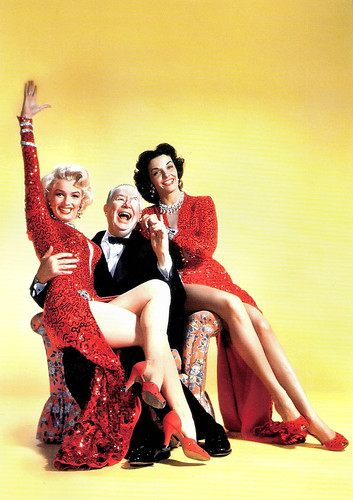
Italian programme card for Il Cinema Ritrovata 2011. Photo: publicity still for Gentlemen prefer blondes (Howard Hawks, 1953) with Marilyn Monroe, Charles Coburn and Jane Russell.

American postcard by Classico, San Francisco, no.105-010. Photo: Twentieth Century-Fox. Marilyn Monroe and Jane Russell in Gentlemen Prefer Blondes (Howard Hawks, 1953).
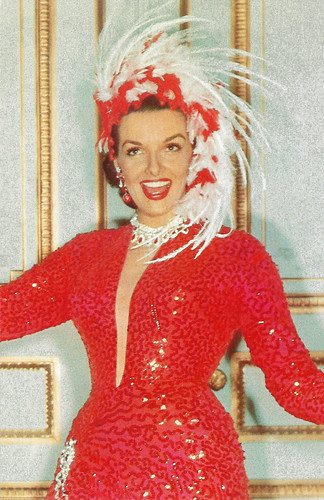
American postcard in the Demac Collection. Photo: Jane Russell in Gentlemen Prefer Blondes (Howard Hawks, 1953).

German postcard by Krüger, no. 902/25.
Most famously, Jane Russell played Dorothy Shaw in the hit musical Gentlemen Prefer Blondes (Howard Hawks, 1953) opposite Marilyn Monroe as Lorelei Lee. The film was a huge success, Russell's biggest hit since The Outlaw, making over $5 million.
Brendon Hanley at AllMovie: "On the surface, Gentlemen Prefer Blondes is a brassy, garish, colorful musical comedy featuring two rather lightweight actresses, Marilyn Monroe and Jane Russell. Ultimately, however, director Howard Hawks uses the nature of the material and the glossy stars to an interesting, paradoxical effect. The film lacks strong masculine characters and any sort of traditional morality; it's dominated by the superficial. The two main characters are sex symbols who, in true Hawksian fashion, have their sex-appeal turned on its head."
Back at RKO she was in Howard Hughes's production The French Line (Lloyd Bacon, 1954), a musical which also starred Gilbert Roland. The films penultimate moment showed Russell in a form-fitting one-piece bathing suit with strategic cutouts, performing a then-provocative musical number titled 'Lookin' for Trouble'. Wikipedia: "In her autobiography, Russell said that the revealing outfit was an alternative to Hughes' original suggestion of a bikini, a very racy choice for a movie costume in 1954. Russell said that she initially wore the bikini in front of her "horrified" movie crew while "feeling very naked."" The film earned $3 million.
Hughes also produced Underwater! (John Sturges, 1955), an adventure film with Russell and Richard Egan at RKO. It made $2 million but because of its large cost was a financial flop. Her contract with Hughes eventually ended in February 1954. Russell co-starred with Clark Gable in The Tall Men (Raoul Walsh, 1955) at Fox, one of the most popular films of the year, with earnings of $6 million. Her own production company Russ-Field produced Gentlemen Marry Brunettes (Richard Sale, 1955), a sequel to Blondes in which Russell starred alongside Jeanne Crain, for release through United Artists. It was not as successful as the original.
Russell made Hot Blood (Nicholas Ray, 1956) with Cornel Wilde at Columbia and The Revolt of Mamie Stover (Raoul Walsh, 1956) at Fox, in the latter playing a role meant for Marilyn Monroe. None of these films were particularly successful. Russell again returned to music while completing several other films in the 1960s.
Jane Russell starred in more than 20 films throughout her career. Her final film was Darker than Amber (Robert Clouse, 1970), a film adaptation of John D. MacDonald's suspense novel, starring Rod Taylor as Travis McGee. Russell often played cynical, 'tough broads,' and in 1971, she starred in the Broadway musical Company.
In 1985, she published the autobiography 'Jane Russell: My Path and My Detours', in which she noted that she had an affair with John Payne in 1942. The affair ended when Jane realised that she was still in love with her high school sweetheart, football player Robert Waterfield, whom she married in April 1943.
Russell married three times, and adopted three children. Her first marriage with Bob Waterfield ended in a divorce in 1968. Two months after her divorce, Russell married actor Roger Barrett; the marriage ended when he died of a heart attack only two months later in November, 1968. She married real-estate broker John Calvin Peoples in 1974, living with him until his death from heart failure in 1999. Her three adopted children are Tracy Waterfield, Thomas Waterfield and Buck Waterfield.
Russell was unable to have children, after a botched abortion in her teenage years left her infertile. Later, she opposed the use of abortion in any circumstance including rape or incest. She championed the passage of the Federal Orphan Adoption Amendment of 1953, which allowed children of American servicemen born overseas to be placed for adoption in the United States. In 1955, she founded World Adoption International Fund (WAIF), the first international adoption program. Through her organisation, Russell has placed 51,000 children with adoptive families.
She retired to Santa Maria, California, after the death of her third husband in 1999 to be close to her youngest son. In 2006, at age 84, she put together a musical show entitled 'The Swinging Forties' that played twice a month at the Radisson Hotel. The show featured herself and about a dozen local Santa Maria residents, including a choir director, lay preacher and retired police officer. She formed the show out of boredom and because there was nothing much going on in town for the older folks to do.
Jane Russell died at her home in Santa Maria of a respiratory-related illness in 2011. Although rumours circulated that she was buried at Santa Barbara Cemetery, Russell was in fact cremated at Santa Barbara Cemetery and her ashes were scattered at sea.

Spanish card, no. 256.
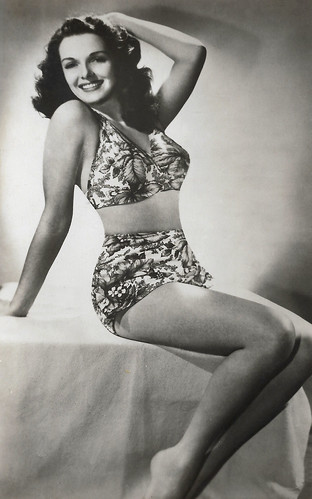
Spanish postcard, no. 280.

Spanish postcard.
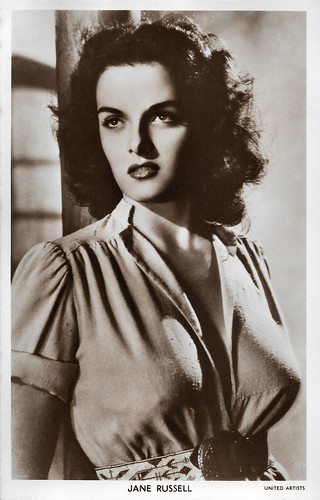
British postcard in the Picturegoer Series, no W 247. Photo: United Artists.

French postcard by Editions du Globe, no. 473. Photo: 20th Century Fox.
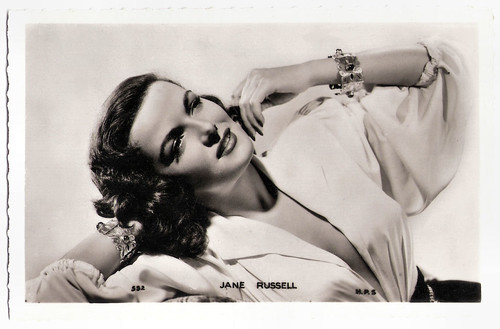
French postcard by Editions P.I., Paris, no. 23 H. Photo: H.P.S.
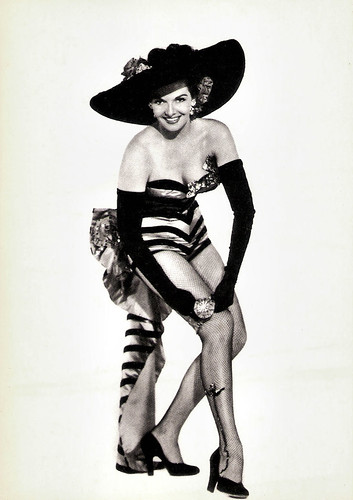
French postcard by Editions P.I., Paris, no. 3359. Photo: Paramount. Publicity still for Son of Paleface (Frank Tashlin, 1952).

Dutch postcard by Foto archief: Film en Toneel, no. AX 269. Photo: RKO Radio Films.
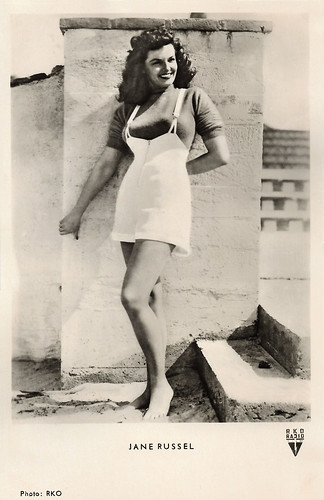
West-German postcard by Kunst und Bild, Berlin, no. A 108. Photo: RKO Radio.

West-German postcard by Kunst und Bild, Berlin, no. A 465. Photo: RKO Radio Film. Publicity still for The Las Vegas Story (Robert Stevenson, 1952).

West-German postcard by Kunst und Bild, Berlin, no. A 957. Photo: RKO Film.

French postcard by Editions P.I., no. 479. Photo: Paramount Pictures Inc., 1953.
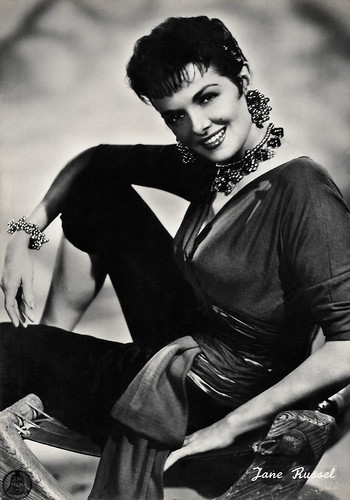
Italian postcard by Bromofoto, Milano, no. 1028. Photo: Dear Film. Publicity still for Gentlemen Marry Brunettes (Richard Sale, 1955).
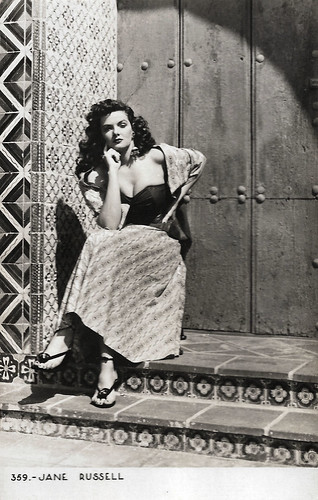
Vintage postcard, no. 359. Photo: Columbia Pictures. Jane Russell in Hot Blood (Nicholas Ray, 1956).

French postcard by Huit, Paris, no. A 8. Photo: 20th Century Fox / ISV. Jane Russell in The Revolt of Mamie Stover (Raoul Walsh, 1956).

Dutch or Belgian postcard, no. AX 293. Photo: United Artists.

French postcard.
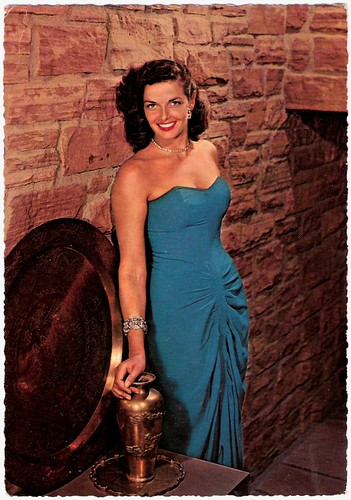
German postcard by Krüger, no. 902/15.
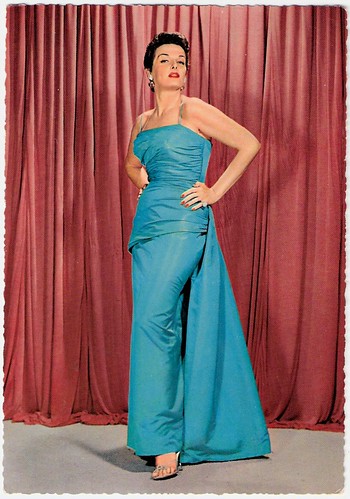
German postcard by Krüger, no. 902/24.
Sources: Brendon Hanley (AllMovie), Denny Jackson (IMDb), AllMovie, Wikipedia and IMDb.

Vintage postcard. Photo: George Hurrell. Publicity still for The Outlaw (Howard Hughes, 1943).

Belgian collectors Card, no. A 50. Photo: Paramount. Jane Russell in The Paleface (Norman Z. McLeod, 1948).

Yugoslavian postcard by Sedmo Silo / IOM, Beograd. Photo: Jane Russell and Brad Dexter in The Las Vegas Story (Robert Stevenson, 1952).

Italian postcard by Bromofoto, Milano, no. 378. Photo: Paramount Films. Jane Russell in Son of Paleface (Frank Tashlin, 1952).

German postcard by Krüger, no. 902/16.
Sex appeal is good - but not in bad taste
Ernestine Jane Geraldine Russell was born in 1921, in Bemidji, Minnesota. She was the only daughter of the five children of Geraldine (née Jacobi) and Roy William Russell. She had four younger brothers: Tom Russell, Kenny Russell, James H. Russell and Wally Russell. Her father had been a first lieutenant in the U.S. Army, and her mother an actress with a road troupe. When Jane was two, her family moved to Southern California where her father worked as an office manager.
Russell's mother arranged for her to take piano lessons. In addition to music, she was interested in drama and participated in stage productions at Van Nuys High School. Her early ambition was to be a designer of some kind, until the death of her father in his mid-40s, when she decided to work as a receptionist after graduation. She also modeled for photographers, and, at the urging of her mother, studied drama and acting with Max Reinhardt's Theatrical Workshop and with acting coach Maria Ouspenskaya.
In 1940, Jane Russell was signed to a seven-year contract by film mogul, Howard Hughes. She made her film debut in the Western The Outlaw (Howard Hughes, 1943), a story about Billy the Kid (Jack Buetel) that went to great lengths to showcase Russell's voluptuous figure. The film was completed in 1941, but it was not released until 1943 in a limited release. Hughes' battles with the censors resulted in the film spending three years on the shelf before finally gaining wide release in a cut version in 1946.
During that time, Russell was kept busy doing publicity and she became known nationally. The film and the controversy turned her into an icon. She was a popular pin-up photo with servicemen during World War II. Wikipedia cites Russell: "Sex appeal is good - but not in bad taste. Then it's ugly. I don't think a star has any business posing in a vulgar way. I've seen plenty of pin-up pictures that have sex appeal, interest, and allure, but they're not vulgar. They have a little art to them. Marilyn's calendar was artistic."
Russell did not appear in another film until 1946, when she played Joan Kenwood in Young Widow (Edwin L. Marin, 1946) opposite Louis Hayward, released through United Artists. The film went over budget by $600,000 and was a box office failure. In 1947 Russell delved into music before returning to films. She sang with the Kay Kyser Orchestra on radio, and recorded two singles with his band. Then, she played Calamity Jane opposite Bob Hope in The Paleface (Norman Z. McLeod, 1948). The film was a sizeable box office hit, earning $4 million. She later also played Mike 'the Torch' Delroy opposite Hope in another Western comedy, Son of Paleface (Frank Tashlin, 1952). It was also a hit.
In between, Howard Hughes cast Russell opposite Robert Mitchum and Vincent Price in the Film Noir His Kind of Woman (1951). The film was originally directed by John Farrow in 1950, but would be re-shot by Richard Fleischer the following year. Russell did two more Film Noirs: The Las Vegas Story (Robert Stevenson, 1952) with Price and Victor Mature, and Macao (Josef von Sternberg, 1952) with Robert Mitchum. His Kind of Woman and Macao were minor hits but both involved so much re-shooting through the interference of Hughes that they lost money.

West-German postcard by Krüger, no. 902/14. Photo: Marilyn Monroe and Jane Russell in Gentlemen Prefer Blondes (Howard Hawks, 1953).

Italian programme card for Il Cinema Ritrovata 2011. Photo: publicity still for Gentlemen prefer blondes (Howard Hawks, 1953) with Marilyn Monroe, Charles Coburn and Jane Russell.

American postcard by Classico, San Francisco, no.105-010. Photo: Twentieth Century-Fox. Marilyn Monroe and Jane Russell in Gentlemen Prefer Blondes (Howard Hawks, 1953).

American postcard in the Demac Collection. Photo: Jane Russell in Gentlemen Prefer Blondes (Howard Hawks, 1953).

German postcard by Krüger, no. 902/25.
Sex symbols used to an interesting, paradoxical effect
Most famously, Jane Russell played Dorothy Shaw in the hit musical Gentlemen Prefer Blondes (Howard Hawks, 1953) opposite Marilyn Monroe as Lorelei Lee. The film was a huge success, Russell's biggest hit since The Outlaw, making over $5 million.
Brendon Hanley at AllMovie: "On the surface, Gentlemen Prefer Blondes is a brassy, garish, colorful musical comedy featuring two rather lightweight actresses, Marilyn Monroe and Jane Russell. Ultimately, however, director Howard Hawks uses the nature of the material and the glossy stars to an interesting, paradoxical effect. The film lacks strong masculine characters and any sort of traditional morality; it's dominated by the superficial. The two main characters are sex symbols who, in true Hawksian fashion, have their sex-appeal turned on its head."
Back at RKO she was in Howard Hughes's production The French Line (Lloyd Bacon, 1954), a musical which also starred Gilbert Roland. The films penultimate moment showed Russell in a form-fitting one-piece bathing suit with strategic cutouts, performing a then-provocative musical number titled 'Lookin' for Trouble'. Wikipedia: "In her autobiography, Russell said that the revealing outfit was an alternative to Hughes' original suggestion of a bikini, a very racy choice for a movie costume in 1954. Russell said that she initially wore the bikini in front of her "horrified" movie crew while "feeling very naked."" The film earned $3 million.
Hughes also produced Underwater! (John Sturges, 1955), an adventure film with Russell and Richard Egan at RKO. It made $2 million but because of its large cost was a financial flop. Her contract with Hughes eventually ended in February 1954. Russell co-starred with Clark Gable in The Tall Men (Raoul Walsh, 1955) at Fox, one of the most popular films of the year, with earnings of $6 million. Her own production company Russ-Field produced Gentlemen Marry Brunettes (Richard Sale, 1955), a sequel to Blondes in which Russell starred alongside Jeanne Crain, for release through United Artists. It was not as successful as the original.
Russell made Hot Blood (Nicholas Ray, 1956) with Cornel Wilde at Columbia and The Revolt of Mamie Stover (Raoul Walsh, 1956) at Fox, in the latter playing a role meant for Marilyn Monroe. None of these films were particularly successful. Russell again returned to music while completing several other films in the 1960s.
Jane Russell starred in more than 20 films throughout her career. Her final film was Darker than Amber (Robert Clouse, 1970), a film adaptation of John D. MacDonald's suspense novel, starring Rod Taylor as Travis McGee. Russell often played cynical, 'tough broads,' and in 1971, she starred in the Broadway musical Company.
In 1985, she published the autobiography 'Jane Russell: My Path and My Detours', in which she noted that she had an affair with John Payne in 1942. The affair ended when Jane realised that she was still in love with her high school sweetheart, football player Robert Waterfield, whom she married in April 1943.
Russell married three times, and adopted three children. Her first marriage with Bob Waterfield ended in a divorce in 1968. Two months after her divorce, Russell married actor Roger Barrett; the marriage ended when he died of a heart attack only two months later in November, 1968. She married real-estate broker John Calvin Peoples in 1974, living with him until his death from heart failure in 1999. Her three adopted children are Tracy Waterfield, Thomas Waterfield and Buck Waterfield.
Russell was unable to have children, after a botched abortion in her teenage years left her infertile. Later, she opposed the use of abortion in any circumstance including rape or incest. She championed the passage of the Federal Orphan Adoption Amendment of 1953, which allowed children of American servicemen born overseas to be placed for adoption in the United States. In 1955, she founded World Adoption International Fund (WAIF), the first international adoption program. Through her organisation, Russell has placed 51,000 children with adoptive families.
She retired to Santa Maria, California, after the death of her third husband in 1999 to be close to her youngest son. In 2006, at age 84, she put together a musical show entitled 'The Swinging Forties' that played twice a month at the Radisson Hotel. The show featured herself and about a dozen local Santa Maria residents, including a choir director, lay preacher and retired police officer. She formed the show out of boredom and because there was nothing much going on in town for the older folks to do.
Jane Russell died at her home in Santa Maria of a respiratory-related illness in 2011. Although rumours circulated that she was buried at Santa Barbara Cemetery, Russell was in fact cremated at Santa Barbara Cemetery and her ashes were scattered at sea.

Spanish card, no. 256.

Spanish postcard, no. 280.

Spanish postcard.

British postcard in the Picturegoer Series, no W 247. Photo: United Artists.

French postcard by Editions du Globe, no. 473. Photo: 20th Century Fox.

French postcard by Editions P.I., Paris, no. 23 H. Photo: H.P.S.

French postcard by Editions P.I., Paris, no. 3359. Photo: Paramount. Publicity still for Son of Paleface (Frank Tashlin, 1952).

Dutch postcard by Foto archief: Film en Toneel, no. AX 269. Photo: RKO Radio Films.

West-German postcard by Kunst und Bild, Berlin, no. A 108. Photo: RKO Radio.

West-German postcard by Kunst und Bild, Berlin, no. A 465. Photo: RKO Radio Film. Publicity still for The Las Vegas Story (Robert Stevenson, 1952).

West-German postcard by Kunst und Bild, Berlin, no. A 957. Photo: RKO Film.

French postcard by Editions P.I., no. 479. Photo: Paramount Pictures Inc., 1953.

Italian postcard by Bromofoto, Milano, no. 1028. Photo: Dear Film. Publicity still for Gentlemen Marry Brunettes (Richard Sale, 1955).

Vintage postcard, no. 359. Photo: Columbia Pictures. Jane Russell in Hot Blood (Nicholas Ray, 1956).

French postcard by Huit, Paris, no. A 8. Photo: 20th Century Fox / ISV. Jane Russell in The Revolt of Mamie Stover (Raoul Walsh, 1956).

Dutch or Belgian postcard, no. AX 293. Photo: United Artists.

French postcard.

German postcard by Krüger, no. 902/15.

German postcard by Krüger, no. 902/24.
Sources: Brendon Hanley (AllMovie), Denny Jackson (IMDb), AllMovie, Wikipedia and IMDb.
No comments:
Post a Comment